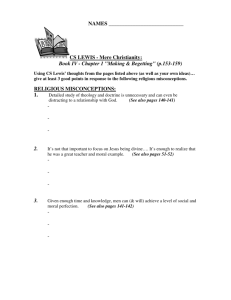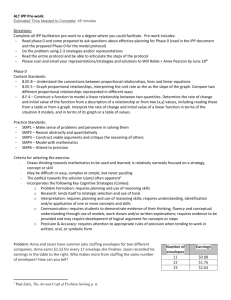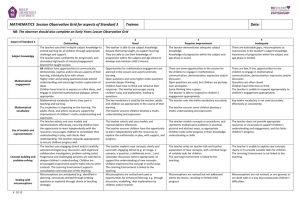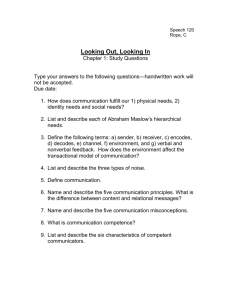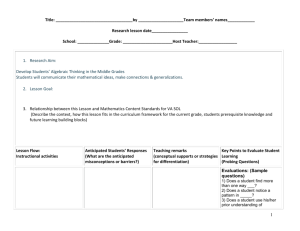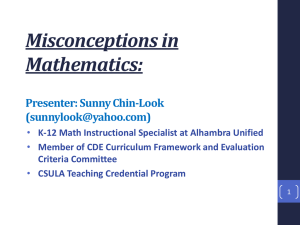Math IPP - Achievement First
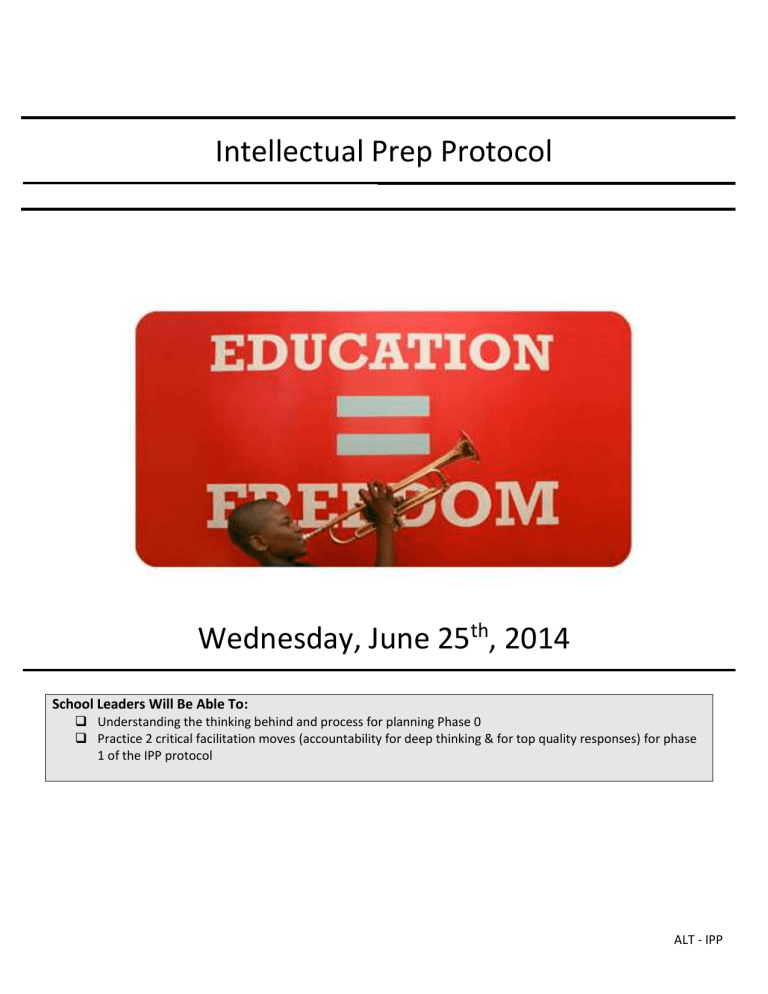
Intellectual Prep Protocol
Wednesday, June 25
th
, 2014
School Leaders Will Be Able To:
Understanding the thinking behind and process for planning Phase 0
Practice 2 critical facilitation moves (accountability for deep thinking & for top quality responses) for phase
1 of the IPP protocol
ALT - IPP
Supporting Intellectual Lift in Planning & Execution - Math
Suggested Process for Rollout
The coach should bring people through this process in three phases:
Phase #
0
Picking the
Math
Description
This phase gets people to a proficient level of understanding the math by making key preparation moves (content and practice standards identification, problem selection and validation).
Through supporting these strong skills of problem selection and alignment, the facilitator also sets the standard for what a strong problem looks like.
Participant Pre-Work
Participants select content and practice standards, articulate the math that should come to light for those standards and choose a rich exercise, problem or task that is conducive to highlighting the desired math learning.
*Note: In the beginning, the facilitator may opt to provide the participant with the standards and exercise/problem/task until the participant is able to do so on his/her own.
1
Depth &
Proficiency in
Content
(Identifying the why, what and how key points)
2
Questioning and
Misconceptions
3
Practice
This phase focuses on crafting the representations and strategies for the exercise or task, ordering them by level of sophistication, and articulating the links between each representation from both an adult and student lens. The phase moves from crafting multiple representations and strategies to synthesizing key points based on the underlying math concepts applied.
This phase focuses on questioning and misconceptions. What are the big meaty questions that will guide the discussions? What are the likely misconceptions (both gap and content) and how, with questioning and other means, will those misconceptions be handled? The phase closes with a revision of the questions and a series of funneled questions for responding to misconceptions
This phase focuses on practicing the execution of the lesson. It focuses on least invasive facilitator moves that support scholars in struggling to precision and ensuring that all minds are on.
Once participants have reached proficiency with pre-work for phase 0, participants complete phase 1 in its entirety as pre-work, ready to present their initial attempt at creating representations, strategies and key points to their coach. This allows for more time to be allocated during the protocol for phases 2 and 3.
Once participants have reached proficiency with pre-work for phases 0 and 1, participants complete phase 2 in its entirety as pre-work, ready to present their initial planning. This allows for more time to be allocated during the protocol for phase 3.
TBD
Facilitator Pre-Work
Facilitator reviews the participant’s pre-work prior to the protocol to check for and provide feedback on alignment between content/practices and the exercise/problem/task as well as alignment of the exercise/problem/task to the criteria outlined in the FOI. Facilitator checks for alignment of the math content and practices within the learning progression of the unit and year.
Facilitator should do the participant’s pre-work, paying particular attention to the connections between the representations, strategies, and key points. Facilitator should be prepared to bring resources to share with participant to facilitate learning
‘the math,’ as needed.
Facilitator should do the participant’s pre-work, paying particular attention to crafting conceptual misconceptions that a large number of students will experience in order to focus the conversation during the protocol.
TBD
Math Intellectual Preparation Protocol: Overview
Phase # Description
Phase 0 will begin with the coach and quickly become pre-work for the teacher
0 – Picking the Define the purpose of the unit
Math Name the focus for the lesson
Select the problem
What students are thinking about
Phase # Description
Phases 1 and 2 should happen either in the meeting or as pre-work depending on the phase of facilitation/level of teacher proficiency.
1 – Depth &
Proficiency in
Content
2 – Questioning and
Misconceptions
3 – Practice
How students are thinking
Craft 2-3 possible solution pathways using multiple representations and strategies
Final check for alignment and revise as needed
Select solution pathway that best illustrates the focal math concepts; and, order alternate pathways to develop depth of understanding and connection making in order to make sense of the most efficient pathway
Articulate the relationship between representations and strategies, and how they validate and/or shed light on the underlying focal math concepts
Synthesize the key why, what and how points linking the focal math concepts to the representations and strategies, and the relationships between them
Draft focal questions to bring out key points
Identify misconceptions
Revise focal questions to draw out and address misconceptions
Practice delivery
Math Intellectual Preparation Protocol: Prompts & Resources
Phase # Description Prompts/Questions
Phase 0 will begin with the coach and quickly become pre-work for the teacher
Define the purpose of the unit What are the big ideas or concepts of the unit?
Name the focus for the lesson
Select the problem
What students are thinking about
How students are thinking
How will student comprehension of the enduring understandings be developed in this unit?
How does this unit build on what students learned earlier in the year? In previous grades?
How does this unit set students up for what comes next this year? Next year?
Which aims support or apply this concept (within this unit)?
Which content standards support or apply this concept?
Which focal SMP from the unit supports this concept?
Which concept(s) am I prioritizing developing during this lesson?
Select a problem that aligns to the prioritized math from steps 1 and 2
Do the problem as an initial check for alignment
How does the selection align to the prioritized math at this time in the unit?
(Aim(s) and concept(s) named?)
How are the selected content standards being addressed in this problem?
Does the selection address the content standards at the right level?
What are the opportunities for students to engage in the prioritized SMP?
To what extent does the problem provide opportunity for students to apply additional standards of mathematical practice?
To what extent does the exercise or task meet the criteria defined in the FOI for this lesson type?
Phase # Description Prompts/Questions
Phases 1 and 2 should happen either in the meeting or as pre-work depending on the phase of facilitation/level of teacher proficiency.
Craft 2-3 possible solution pathways using multiple representations and strategies
What are all the ways to approach the exercise/problem/task?
How would you approach this concretely? Pictorially? Abstractly?
Final check for alignment and revise as needed
Select solution pathway that best illustrates the focal math concepts; and, order alternate pathways to develop depth of understanding and connection making in order to make sense of the most efficient pathway
Articulate the relationship between representations and strategies, and how they
How does understanding each representation and strategy support the understanding of the others and the math being applied?
Resources
Unit Plan
Unit Plan
Resources named in FOI
Unit Plan
CC Standards
Document
FOI
CC Standards
Document
Resources
Unit Plan and
Assessment, Engage NY
Materials, Progression
Documents, Source of exercise or task, colleagues/coach
Is the math selected the most natural way to approach the selected problem or a natural build upon student understanding to culminate in new learning?
Which solution pathway most naturally addresses the underlying math concepts?
In what order should the alternate pathways be presented by students in order to lead their classmates to understand the target pathway?
See above
See above
validate and/or shed light on the underlying focal math concepts
Synthesize the key why, what and how points linking the focal math concepts to the representations and strategies, and the relationships between them
Draft focal questions to bring out key points
In kid friendly language, what are the key points (why, what and how)?
Identify misconceptions
Revise focal questions to draw out and address misconceptions
What do students need to be considering in order to be ready to engage in the logic of the concepts?
What sense making, reasoning and probing questions will support students in thinking about and developing an understanding of the focal strategies, representations, practices and concepts needed to tackle the problem?
What are the questions that get kids to consider the most important ideas while preserving or pushing student thinking?
Grade level content misconceptions
What are the 1-2 misconceptions students will likely have that impede comprehension?
How will you respond to each one?
Will you play out the misconception or fix it?
If played out, to what end?
If fixed, will it be for an individual, the whole group or a small group?
What do kids need to experience or see in order to change their logic/increase their mathematical intuition?
Pre-requisite content knowledge gaps + misconceptions
What are the 1-2 pre-requisite knowledge and skill issues you are likely to see?
How will those prevent students from accessing the content?
Will you fix them beforehand or in the moment? Using:
Adjusting the entry point
Tools/manipulatives provided
Language
The exercise/problem/task
Student groupings
Do your initial focal questions provide an opportunity for misconceptions to come to life and lead students through an experience that shift their thinking and solidify their understanding?
What additional questions do you need incorporate to draw out and address misconceptions in order to help students see the logic required to understand the focal concepts?
See above
AF Mathematics
Questioning Guide
“Transformative
Assessment in Action.”
James Popham.
Unit plan
Colleagues
In development NA NA
Participant Note Taking Sheet
Phase 0: Picking the Math
Purpose of the Unit
Big Ideas of the Unit
An expression in one variable defines a general calculation with the variable representing the input and the expression calculating the output. Choosing a variable to represent the output creates an equation in two variables.
A linear equation in one variable can have one solution, no solution, or infinitely many solutions. A linear equation in two variables has an infinite number of solutions.
When two quantities, x and y, vary in such a way that one of them is a constant multiple of the other, a model for that situation is y=kx where k is the constant of proportionality or the constant ratio of y to x. An equation is proportional if it includes the point (0,0) and is a straight line.
Rates of change communicate critical information about a linear relationship. Rates of change are synonymous with unit rate for proportional relationships.
Lines have a constant rate of change because the ratio of the rise to run between any two points on a line is the same.
Builds on the following:
In 7 th grade, students learn to recognize proportional relationships represented graphically, algebraically and
In tabular form. Additionally, they learn to describe the unit rate as the Constant of Proportionality and understand that proportional relationships are identified by a unit rate.
Students build on a basic understanding of functions as a means of representing a relationship between two quantities. They have also just engaged with finding and comparing rates of change given multiple representations of these relationships (table, graph, equation, and context) in the functions unit.
Sets students up for the following:
A solid understanding of proportional relationships and unit rate grounds students’ understanding of rates of change.
Throughout the rest of the unit on linear equations, students will continue to apply rates of change to work with graphs, tables and equations as well as systems of equations. Additionally, when students learn about bivariate data, they will apply their understanding of
Rates of Change in order to understand trends and make predictions.
Eventually, in High School, students will build on their understanding of rates of change as they apply them to non-linear relationships using average rate of change, which eventually facilitates meaningful engagement with limits and derivatives
The Focus of the Lesson
Which aim(s) am I prioritizing?
SWBAT graph proportional relationships, interpreting the unit rate as the slope of the graph.
SWBAT determine if a relationship is proportional.
Which content standard does this aim connect to?
8.EE.B – Understand the connections between proportional relationships, lines and linear equations
8.EE.5 – Graph proportional relationships,
SWBAT compare two different proportional relationships represented in different ways by
determining the unit/rate slope and graphing interpreting the unit rate as the as the slope of the graph. Compare two different proportional relationships represented in different ways
8.F.4 – Construct a function to model a linear relationship between two quantities. Determine the rate of change and initial value of the function from a description of a relationship or from two (x,y) values, including reading these from a table or from a graph. Interpret the rate of change and initial value of a linear function in terms of the situation it models, and in terms of its graph or a table of values
Which focal SMP supports this concept? Which concept(s) am I prioritizing during this lesson?
SMP1 – Make sense of problems and persevere in solving them
SMP2 – Reason abstractly and quantitatively
SMP3 – Construct viable arguments and critique the reasoning of others
SMP4 – Model with mathematics
SMP6 – Attend to precision
Rates of change communicate critical information about a linear relationship.
Rates of change are synonymous with unit rate for proportional relationships.
Exercise or Task
Problem: Anna and Jason have summer jobs stuffing envelopes for two different companies. Anna earns $1.53 for every 17 envelops she finishes.
Jason recorded his earnings in the table to the right. Who makes more from stuffing the same number of envelopes? How can you tell?
Number of envelopes
11
22
33
Earnings
$0.88
$1.76
$2.64
The What of the Problem
How does the problem align to the priority aims, standards, and concepts named above?
The problem involves the comparison of two different representations of relationships, both proportional, and a justification of the conclusion of that comparison. This ties directly to the prioritized aim “represented in
different ways by determining the unit rate/slope and graphing,” and sets students up to understand the utility of finding a unit rate for mathematical purposes and given the context. Also, students will have the opportunity to make a connection between the slope and unit rate. The problem was tuned to incorporate multiple representations so that it aligns fully to the 8 th grade standard.
The How of the Problem
How are students applying the SMP(s) in this problem?
Students have to come up with a way of modeling the situation that allows for comparison. Whether that’s with a graph, a table, equation, or with another method – they will be modeling and then constructing an argument based on the conclusions they draw from their model. This process is how we are connecting to SMP 3 and 4.
While SMPs 1 and 2 are not a focus of the problem, the numbers were changed to increase the amount of reasoning and sense making required of the students.
To what extent does the problem align to the FOI criteria?
The problem draws thinking towards the mathematics required, and we tweaked the problem in order to make this math clearer. The problem is challenging, but relatively straight forward to interpret, and also requires communication of a conclusion and the thinking behind that conclusion. The criteria that are more in the background of this problem and not a clear focus are research, interpretation, precision and accuracy.
Criteria for Exercise
Draws thinking towards mathematics to be used and learned; is relatively narrowly focused on a strategy, concept or skill
May be difficult or easy, complex or simple, but never puzzling
The path(s) towards the solution is(are) often apparent
Incorporates the following Key Cognitive Strategies (Conley): o Problem Formation: requires planning and use of reasoning skills o Research: lends itself to strategic selection and use of tools o Interpretation: requires planning and use of reasoning skills; requires understanding, identification and/or application of one or more concepts and skills o Communication: requires students to demonstrate evidence of their thinking, fluency and conceptual understanding through use of models, work shown and/or written explanations; requires evidence to be provided and may require development of logical argument for concepts or steps o Precision & Accuracy: requires attention to appropriate rules of precision when tending to work in written, oral, or symbolic form
-
-
-
-
Criteria for Problem/Task
Draws thinking towards mathematics to be used and learned
Incorporates the following Key Cognitive Strategies (Conley): o Problem Formation: requires planning and use of reasoning skills o Research: lends itself to strategic selection and use of tools o Interpretation: requires planning and use of reasoning skills; requires understanding, identification and/or application of multiple concepts and skills o Communication: requires students to demonstrate evidence of their thinking, fluency and conceptual understanding through use of models, work shown and/or written explanations; requires evidence to be provided and may require development of logical argument for concepts o Precision & Accuracy: requires attention to appropriate rules of precision when tending to work in written, oral, or symbolic form
Non-routine and complex
Solution path is neither stated or obvious; may be multiple solution paths; may be multiple solutions
Phase 1: Depth and Proficiency in Content
Craft 2-3 solution pathways using multiple representations and strategies
Scan and paste handwritten solution pathways.
** Check for natural alignment of exercise, problem or task to math focal points, and revise as needed
Prioritize and Order Pathways
Pathway 1 Pathway 2 Target Pathway
Select solution pathway that best illustrates the focal math concepts; and, order alternate pathways to develop depth of understanding and connection making in order to make sense of the most efficient pathway
Articulate the relationship between representations and strategies, and how they validate and/or shed light on the underlying focal math concepts
Synthesize the key why, what and how points linking the focal math concepts to the representations and strategies, and the relationships between them
Why What How
Phase 2: Questioning and Misconceptions
What do students need to be considering in order to be ready to engage in the logic of the concepts?
What sense making, reasoning and probing questions will support students in thinking about and developing an understanding of the focal strategies, representations, practices and concepts needed to tackle the exercise or task?
What are the questions that get kids to consider the most important ideas while preserving or pushing student thinking?
Questioning to Encourage Student Thinking
What questions will you ask to get students to:
-
Make sense of the problem?
-
-
Reason about the mathematical concepts being applied?
Reveal their depth of understanding?
Question Type of Question
Sense Making
Reasoning
Probing
Sense Making
Reasoning
Probing
Sense Making
Reasoning
Probing
Sense Making
Reasoning
Probing
Sense Making
Reasoning
Probing
Sense Making
Reasoning
Probing
Identifying Misconceptions
What are the key misconceptions that will obstruct student success?
Grade Level Content Misconceptions
Pre-requisite Misconceptions
What logic led to the misconception?
What logic led to the misconception?
** Revise focal questions to draw out and address misconceptions
Teacher Response
Teacher Response
